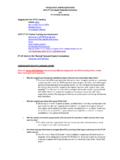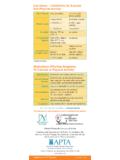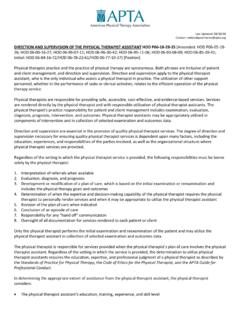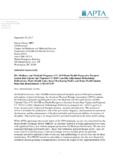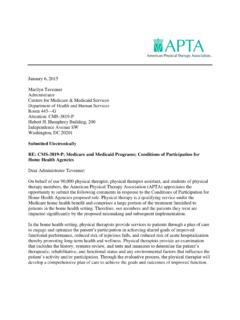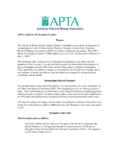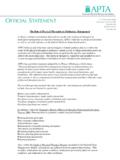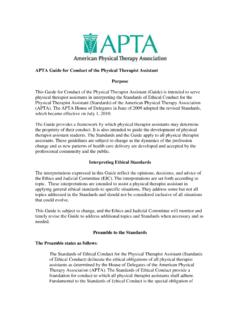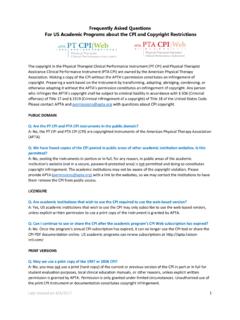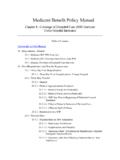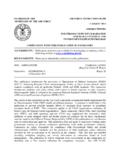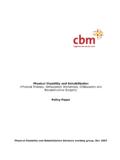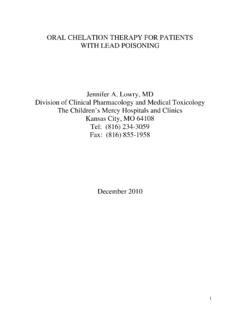Transcription of Practice-Based Evidence Study Design Presentation …
1 11/3/2009 Horn apta Presentation Dec 2-4, 20091 Practice-Based Evidence Study DesignA Systematic Approach to Physical therapy Documentation for Comparative Effectiveness Research1 Susan D. Horn, for Clinical Outcomes Research699 E. South Temple, Suite 300 Salt Lake City, Utah 84102-1282801-466-5595 (T) 801-466-6685 (F) Presentation OverviewPresentation Overview Brief description of PBE, a practiceBrief description of PBE, a practice-- based Evidence based Evidence approach to comparative effectiveness of treatments, approach to comparative effectiveness of treatments, and how it compares with other Study methodologies, and how it compares with other Study methodologies.
2 Particularly RCTsparticularly RCTs22particularly RCTsparticularly RCTs PBE examples of comparative effectiveness findings PBE examples of comparative effectiveness findings about physical therapy activities and processes for about physical therapy activities and processes for stroke rehabilitationstroke rehabilitation How to implement PBE documentation in daily How to implement PBE documentation in daily workflowworkflowPracticePractice-- based Evidence Study DesignBased Evidence Study DesignProcess FactorsProcess Factors Management StrategiesManagement Strategies InterventionsInterventionsMdi tiMdi tiImprove/Standardize:Improve/Standardiz e:Measure:Measure.
3 3 MedicationsMedicationsPatient FactorsPatient Factors Psychosocial/demographic FactorsPsychosocial/demographic Factors Disease(s)Disease(s) Severity of Disease(s)Severity of Disease(s) physiologic signs and symptomsphysiologic signs and symptoms Genetic informationGenetic information Multiple Points in TimeMultiple Points in TimeOutcomesOutcomes Clinical Clinical Health StatusHealth Status FunctionalFunctional Cost/LOS/EncountersCost/LOS/EncountersCo ntrol for:Control for:Why PracticeWhy Practice-- based Evidence ?
4 based Evidence ?PBE is a validated, timely, costPBE is a validated, timely, cost--effective method to effective method to assess comparative effectiveness of specific assess comparative effectiveness of specific interventions: devices, drugs, treatment processesinterventions: devices, drugs, treatment processesPBE t di ff ti f i tti d i PBE t di ff ti f i tti d i 4 PBE studies compare effectiveness of interventions used in PBE studies compare effectiveness of interventions used in clinical practice by many providers, overcoming limitations clinical practice by many providers, overcoming limitations of RCTsof RCTs More detailed patient, process, and outcome evaluation than More detailed patient, process.
5 And outcome evaluation than is possible with traditional registriesis possible with traditional registries Useful when RCT is impractical or unethicalUseful when RCT is impractical or unethical7 Signature Features of PBE Studies1. Hypotheses can be focused or broad2. Consider all interventions to determine relative tib tifh5contribution of each 3. Minimal patient selection criteria maximize generalizability and external validity4. Detailed characterization of the patient by robust measures of patient severity, genetic information, and functional status7 Signature Features of PBE Studies5.
6 Patient differences controlled statistically rather than through randomization and clinical/patient buy-inthrough use of and clinical/patient buyin through use of transdisciplinary Clinical Practice Team7. Strength of Evidence built through the research processPBE findings are more generalizableand transportablethan RCT findings11/3/2009 Horn apta Presentation Dec 2-4, 20092 PBE Signature Feature: Interventions 2. Consider all interventions to determine relative contribution of each. Uses a detailed characterization of the care7 Uses a detailed characterization of the care process through a well-designed point-of-care (POC) documentation system User-defined and user friendly Time sensitive characterization of all interventionsPBE Signature Feature: Patients 4.
7 Detailed characterization of the patient by robust measures of individual severity and functional status Includes Comprehensive Severity Index (CSI )8 Over 2,200 condition-specific signs, symptoms, and physical findings Continuous score: 0 Admission, discharge, maximum during stay, visit Genetic information Includes Functional Independence Measure (FIM) and/or other measures of functional statusPBE Signature Feature: Clinical Practice Team 6. Facility and clinical buy-in through use of transdisciplinary Clinical Practice Team that: Develops and frames the questions Defines variables9 Defines variables Gathers data Interprets data Implements findings Fosters clinical and individual buy-in (bottom-up) Facilitates knowledge translationPBE Signature Feature: Strength of Evidence 7.
8 Strength of Evidence built through the research process Added confounders preserve the significant10 Added confounders preserve the significant association A change in outcomes follows a change in treatment as predicted by the PBE model Repeated studies on the same topic yield similar findingsPBE Hallmarks Non-experimental: Follows outcomes of treatments actually prescribed Inclusive: Uses patient populations undergoing 1111pppggroutine clinical care Pragmatic: Uses actual clinical outcomes Lower Cost than RCTs Faster than RCTsPBE and RCT Compared What is efficacious in randomized clinical trials is not always effective in real world of day-to-day 12 Practice-Based research provides the laboratory that will help generate new knowledge and bridge the chasm between recommended care and improved care.
9 JM Westfall, et al. Practice-Based Research Blue Highways on the NIH Roadmap. JAMA (January 24/31, Vol 297, No. 4, 2007: apta Presentation Dec 2-4, 20093 PBE and RCTRCTRCT13 PBEPBEP rogenitor of Progenitor of RCTsRCTsPractice effects Practice effects of RCT resultsof RCT resultsPBE StudyPBE Study Connects outcomes with detailed process Connects outcomes with detailed process stepssteps14stepssteps Adjusts for severity of illness to control Adjusts for severity of illness to control for patient differences/selection biasfor patient differences/selection biasComprehensive Severity Index (CSIC omprehensive Severity Index (CSI )))
10 Disease-specific: over 2,200 individual criteria subdivided ver 2,200 individual criteria subdivided into more than 5,500 diseaseinto more than 5,500 disease--specific groupsspecific groups No treatments No treatments used as criteriaused as criteria1515 Comprehensive (all diseases) Clinically credible: computes diseaseomputes disease--specific and overall specific and overall severity levelsseverity levels Can measure severity at multiple time points Statistically valid explanation of costs/outcomesCoronary Artery Disease Coronary Artery Disease --IHDIHDD isease codes 411 Disease codes.
